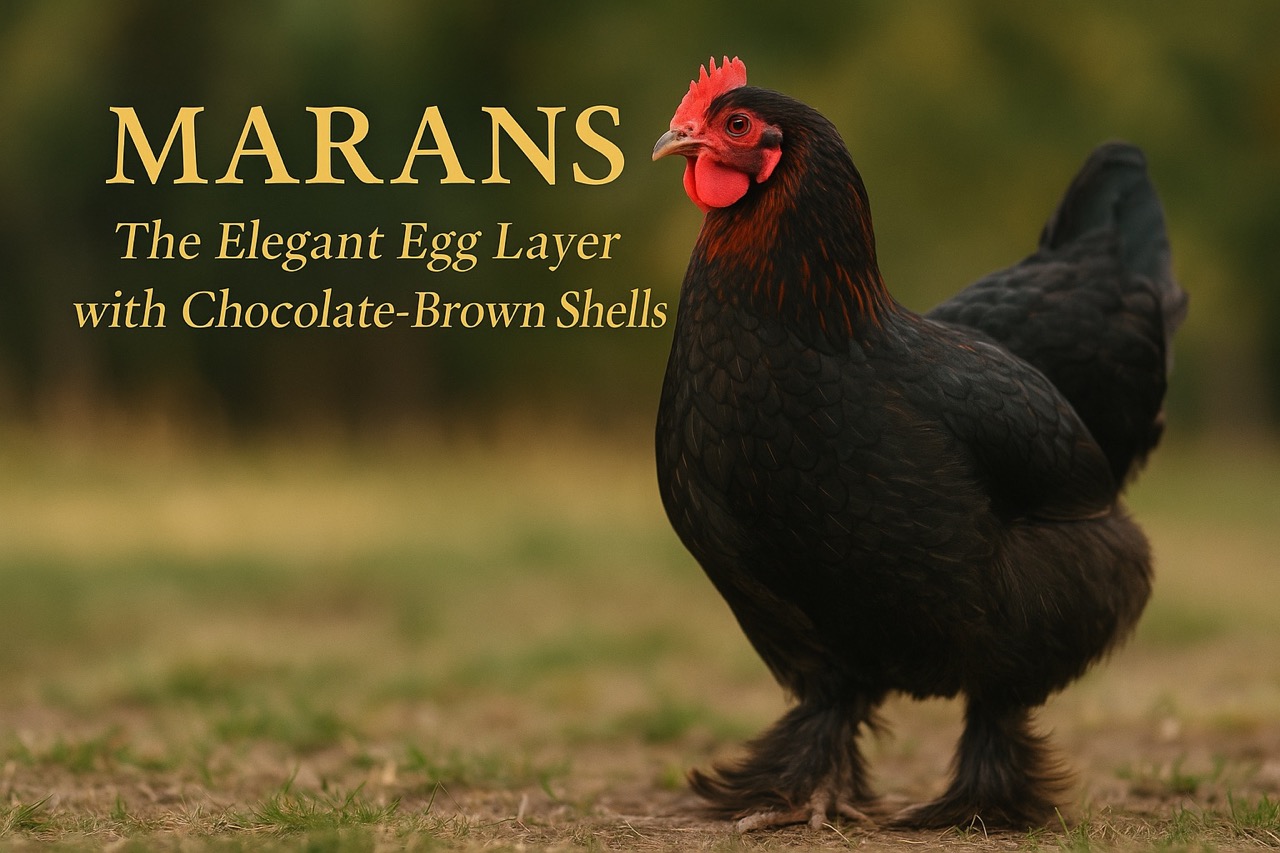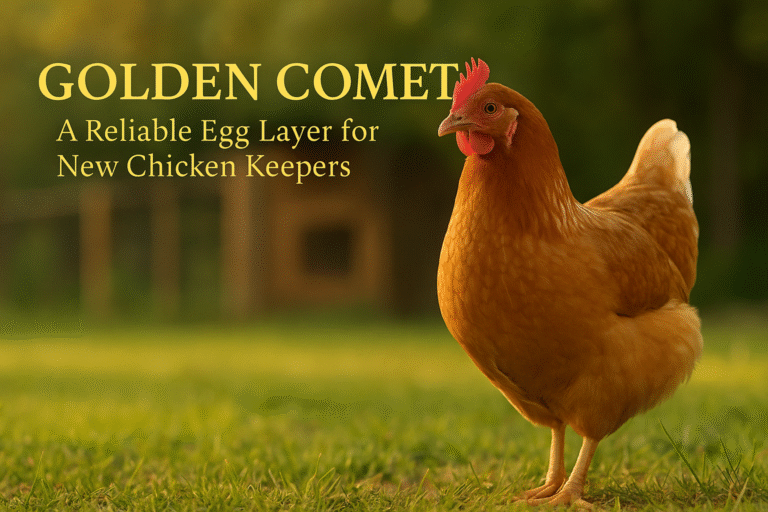The Marans chicken brings both beauty and boldness to the backyard. With their rich mahogany or black plumage, feathered legs, and dark chocolate-brown eggs, Marans are a stunning and productive addition to any flock. While not the most beginner-proof bird, they’re surprisingly hardy and gentle — especially when handled regularly.
📜 Breed Overview
- Breed Name: Marans (pronounced “mah-RAHN”)
- Origin: France
- Type: Dual-purpose (eggs & meat)
- Temperament: Calm, regal, somewhat shy
- Egg Color: Deep brown (“chocolate eggs”)
- Egg Production: 150–200 eggs/year
- Climate Tolerance: Cold hardy; tolerates moderate heat
- Best For: Intermediate beginners, egg color collectors, heritage breed enthusiasts
🌟 Why Choose the Marans Chicken?
Marans offer a balance of beauty, function, and rarity that few breeds match.
🍫 Chocolate-Brown Eggs — One of the darkest egg layers available, with eggs ranging from brick red to nearly black.
💎 Stunning Appearance — Varieties like Black Copper Marans feature iridescent black plumage with copper neck highlights and lightly feathered legs.
🧘 Calm Demeanor — Often reserved or shy, but not aggressive. Gentle when socialized from a young age.
🌬️ Cold-Hardy Build — Dense feathers and broad bodies allow them to thrive in northern climates.
🧠 Temperament: Regal and Reserved
Marans chickens are generally:
- Calm and quiet, not flighty
- Mildly standoffish at first, but will warm up with gentle care
- Polite in mixed flocks, not aggressive or dominant
- A great choice if you prefer a peaceful flock without constant energy
They’re not lap chickens by default, but they’re highly manageable — and impressively elegant.
🥚 Egg Production: Beautiful but Moderate
Marans lay 150 to 200 eggs per year, usually medium to large in size, and the shell color is their true selling point.
- Egg color: Ranges from dark reddish-brown to deep chocolate
- Shell strength: Very hard and glossy
- Lay rate: 3–4 eggs per week in peak season
- Laying start: Usually around 6 months
💡 Tip: The darkest eggs usually come from Black Copper Marans, especially in the first year.
🌡️ Climate Tolerance: Great for the Cold, Fine in Heat
Marans are well-suited to colder regions due to their dense feathering and robust size. They also tolerate moderate heat if shade and water are available.
✅ Ideal for:
- ❄️ Northern U.S., Canada, mountain homesteads
- ☀️ Warm climates with basic summer care
🚫 Avoid keeping them in hot, humid conditions without proper ventilation — their feathered legs can trap mud and moisture.
🏡 Who Are Marans Chickens Best For?
- ✅ Intermediate beginners who want unique eggs
- ✅ Keepers in cold regions
- ✅ Small farms or hobbyists interested in heritage breeds
- ✅ Flock owners who enjoy quiet, graceful birds
- ✅ Egg collectors and farmers market sellers
🧰 Tips for Raising Marans
🐣 Socialization Matters:
- Handle them young to avoid shyness later
- Offer treats and hand-feeding for bonding
🧼 Keep Those Legs Clean:
- Feathered feet can collect mud in rainy seasons
- Dry bedding or sand runs help reduce mess
🥚 Dark Egg Maintenance:
- Give breaks between laying cycles
- Don’t overbreed — crossbreeding often dilutes egg color
🏡 Space & Shelter:
- 5 sq ft inside, 10–12 sq ft outside per bird
- Protect from muddy, wet flooring to prevent feather-foot rot
💭 Final Thoughts: The Aristocrat of the Chicken Yard
The Marans chicken brings a mix of mystique, elegance, and rare egg color to any coop. While not the fastest layer, she offers charm, poise, and one of the most coveted egg shades in the poultry world.
For beginner keepers looking to level up — or those who want a quiet, photogenic addition to the flock — Marans are an unforgettable choice.
🐔 Related Reading from Paranoid Prophet
- Backyard Eggs vs Store-Bought – Shell Color Matters
- Broody Hen Behavior – What It Means and How to Handle It
- Backyard Chickens for Kids – What to Know
- Backyard Chickens & Ethical Living
- How Many Chickens Should I Start With?
🔗 External Resources on Marans Chickens
🐔 Breed Profiles & Care Guides
- Practical Self Reliance – Marans Chicken Breed Guide
A comprehensive overview covering Marans chickens’ characteristics, egg production, and suitability for backyard flocks. Practical Self Reliance
🧬 History & Breed Origins
- Poultry Keeper – Marans Chickens
Information on the development of the Marans breed in the 1920s near the town of Marans, France, and their distinctive dark brown eggs. poultrykeeper.com+1AgronoMag+1
🏡 Practical Tips & Personal Experiences
- The Feather Brain – Considering Marans Chickens? The 14 Things You Must Know First
A detailed guide covering essential considerations for prospective Marans chicken owners. The Featherbrain - Roobeez – Black Copper Marans Guide
An owner’s perspective on raising Black Copper Marans, discussing their balance between egg-laying and meat production. Roobeez
❓ Frequently Asked Questions About Marans Chickens
What are Marans chickens known for?
Marans chickens are best known for their dark chocolate-brown eggs — among the darkest of any breed. They’re also admired for their elegant appearance, feathered legs, and calm, quiet personalities.
What color eggs do Marans chickens lay?
Marans hens lay rich, dark brown eggs, with shades ranging from terra-cotta to nearly black. The Black Copper Marans variety lays the darkest eggs, especially during the first year of laying.
How many eggs do Marans chickens lay per year?
Marans hens lay approximately 150 to 200 eggs per year. While not the most prolific layers, their eggs are prized for both appearance and shell strength.
When do Marans chickens start laying?
Marans chickens typically begin laying around 24 to 28 weeks of age (6–7 months). Their slower maturity is common among heritage and dual-purpose breeds.
Are Marans chickens friendly?
Yes — Marans are generally calm and well-mannered, though they may be shy at first. With regular handling, they become docile, curious, and easy to manage. They’re well-suited to peaceful flocks and family settings.
Are Marans chickens good for beginners?
They can be! Marans are ideal for intermediate beginners — especially those who want a unique egg color and a quiet flock member. They’re hardy and relatively low-maintenance, but may be more reserved than typical beginner breeds like Golden Comets or Orpingtons.
Do Marans chickens tolerate cold weather?
Yes — Marans are very cold-hardy thanks to their dense feathering and broad bodies. They do especially well in northern climates, provided they have draft-free coops and dry footing.
Can Marans chickens live in hot climates?
Marans can tolerate moderate heat, but their feathered legs and dark plumage mean they’re best kept in shaded areas with proper ventilation during hot months. Humidity can be challenging if runs stay muddy.
Do Marans chickens have feathered feet?
Yes — most Marans varieties, especially Black Copper Marans, have lightly feathered legs and toes. It’s part of what makes them so visually striking. Keep leg feathers clean to avoid buildup in wet environments.
How long do Marans chickens live?
With proper care, Marans typically live 5 to 8 years. Their laying peaks in the first 2–3 years, then slows gradually, like most heritage breeds.




